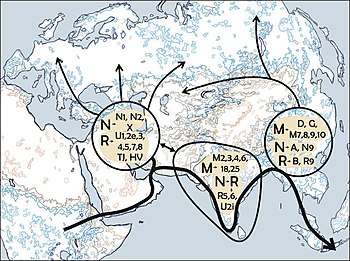Southern Dispersal
- See Coastal migration (Americas) for the "coastal migration" scenario in the first peopling of the Americas.

In the context of the recent African origin of modern humans, the Southern Dispersal scenario (also the coastal migration hypothesis) refers to the early migration along the southern coast of Asia, from the Arabian peninsula via Persia and India to Southeast Asia and Oceania.[1] Alternative names include the "southern coastal route"[2] or "rapid coastal settlement".[3]
The coastal route theory is primarily used to describe the initial peopling of the Arabian peninsula, India, Southeast Asia, New Guinea, Australia, Near Oceania, coastal China, and Japan between roughly 70,000 to 60,000 years ago.[4][5]
It is linked with the presence and dispersal of mtDNA haplogroup M and haplogroup N, as well as the specific distribution patterns of Y-DNA haplogroup C and haplogroup D, in these regions.[3][6][7]
The theory proposes that early Homo sapiens, some of the bearers of mitochondrial haplogroup L3 arrived in the Arabian peninsula about 70,000 years ago, crossing from East Africa via the Bab-el-Mandeb straits. It has been estimated that from a population of 2,000 to 5,000 individuals in Africa, only a small group, possibly as few as 150 to 1,000 people, crossed the Red Sea.[8] The group would have travelled along the coastal route around Arabia and Persia to India relatively rapidly, within a few thousand years. From India, they would have spread to Southeast Asia ("Sundaland") and Oceania ("Sahul").[5]
See also
References
- ↑ Phillip Endicott; Mait Metspalu; Toomas Kivisild (2007), The Evolution and History of Human Populations in South Asia: Inter-disciplinary Studies in Archaeology, Biological Anthropology, Linguistics and Genetics (PDF), Springer Netherlands, ISBN 978-1-4020-5561-4,
... The concept of a coastal migration was already envisioned in 1962 by the ...
- ↑ Metspalu et al 2006, Human Mitochondrial DNA and the Evolution of Homo sapiens.
- 1 2 Vincent Macaulay; et al. (13 May 2005), "Single, Rapid Coastal Settlement of Asia Revealed by Analysis of Complete Mitochondrial Genomes; Vol. 308. no. 5724", Science Magazine, 308 (5724), pp. 1034–1036, doi:10.1126/science.1109792, PMID 15890885,
... mitochondrial DNA variation in isolated "relict" populations in southeast Asia supports the view that there was only a single dispersal from Africa, most likely via a southern coastal route, through India and onward into southeast Asia and Australasia. There was an early offshoot, leading ultimately to the settlement of the Near East and Europe, but the main dispersal from India to Australia 65,000 years ago was rapid, most likely taking only a few thousand years. ...
- ↑ Kevin O. Pope; John E. Terrell (9 Oct 2007), "Environmental setting of human migrations in the circum-Pacific region", Journal of Biogeography, 35 (1), pp. 1–21, doi:10.1111/j.1365-2699.2007.01797.x,
... The expansion of modern humans out of Africa, following a coastal route into southern Asia, was initially thwarted by a series of large and abrupt environmental changes. A period of relatively stable climate and sea level from c. 45,000 yr bp to 40,000 yr bp supported a rapid coastal expansion of modern humans throughout much of Southeast Asia, enabling them to reach the coasts of northeast Russia and Japan by 38,000–37,000 yr bp ...
- 1 2 Spencer Wells (2002), The Journey of Man: A Genetic Odyssey, Princeton University Press, ISBN 069111532X,
... the population of south-east Asia prior to 6000 years ago was composed largely of groups of hunter-gatherers very similar to modern Negritos ... So, both the Y-chromosome and the mtDNA paint a clear picture of a coastal leap from Africa to south-east Asia, and onward to Australia ... DNA has given us a glimpse of the voyage, which almost certainly followed a coastal route via India ...
- ↑ Searching for traces of the Southern Dispersal Archived 10 May 2012 at the Wayback Machine., by Dr Marta Mirazón Lahr, et al.
- ↑ "The Genographic Project: Genetic Markers, Haplogroup D (M174)", National Geographic, 2008, archived from the original on 5 April 2008,
... Haplogroup D may have accompanied another group, the Coastal Clan (haplogroup C) on the first major wave of migration out of Africa around 50,000 years ago. Taking advantage of the plentiful seaside resources, these intrepid explorers followed the coastline of Africa through the southern Arabian Peninsula, India, Sri Lanka, and Southeast Asia. Alternatively, they may have made the trek at a later time, following in the footsteps of the Coastal Clan ...
- ↑ Zhivotovsky; Rosenberg, NA; Feldman, MW; et al. (2003). "Features of Evolution and Expansion of Modern Humans, Inferred from Genomewide Microsatellite Markers". American Journal of Human Genetics. 72 (5): 1171–86. doi:10.1086/375120. PMC 1180270. PMID 12690579. Stix, Gary (2008). "The Migration History of Humans: DNA Study Traces Human Origins Across the Continents". Retrieved 14 June 2011.